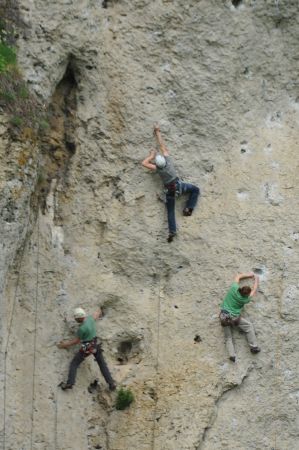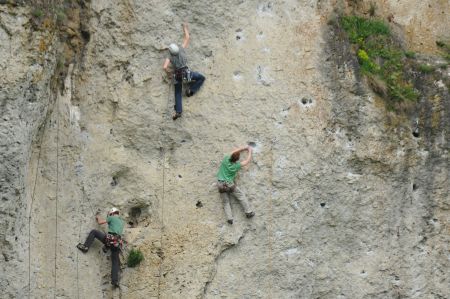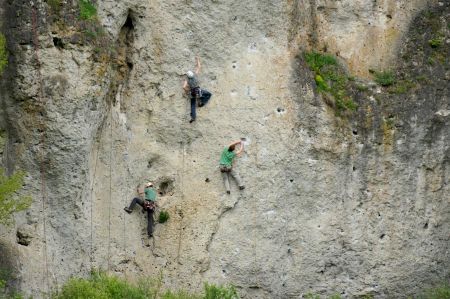During our tour through Franconian Switzerland, we drove in the Wiesenttal along the scenic country road towards Ebermannstadt, which also led along a steep rock face. Here we noticed a few climbers who, because of their colorful clothing, stood out clearly from the grey, weathered rock faces.
Without further ado, the car was parked in a parking lot and a short walk to the climbing wall was completed.
 Climbing has been a natural form of human locomotion since ancient times. Sometimes rocks were climbed for cultural reasons due to religious locations, then again for purely practical reasons to look out for prey or enemies. On the Rabenfels in Franconian Switzerland, for example, potsherds were found that date from the 8th to 4th centuries BC and clearly prove that the Rabenfels was already being climbed at that time. For what reason this happened, however, is still unclear. In the Middle Ages, the inhabitants of Franconian Switzerland at that time used the exposed rocks as a lookout tower to protect them from enemies or as signal towers to transmit warning signals. Climbing was given strategic importance for the first time, although, measured by today's standards, climbers already had to overcome the third level of difficulty.
Climbing has been a natural form of human locomotion since ancient times. Sometimes rocks were climbed for cultural reasons due to religious locations, then again for purely practical reasons to look out for prey or enemies. On the Rabenfels in Franconian Switzerland, for example, potsherds were found that date from the 8th to 4th centuries BC and clearly prove that the Rabenfels was already being climbed at that time. For what reason this happened, however, is still unclear. In the Middle Ages, the inhabitants of Franconian Switzerland at that time used the exposed rocks as a lookout tower to protect them from enemies or as signal towers to transmit warning signals. Climbing was given strategic importance for the first time, although, measured by today's standards, climbers already had to overcome the third level of difficulty.
Beginning of free climbing on the Falkenstein in Saxon Switzerland
 It was only in 1864 that sportive climbing was born, when Schandauer gymnasts climbed the Falkenstein in Saxon Switzerland. A few years later, around 1890, free climbing had established itself as a leisure sport in Franconian Switzerland. The climbers try to climb the rocks without using technical aids. From here, free climbing took its course, but initially only sporadically in the Franconian Switzerland region. In the 1950s, John Gill shaped bouldering, popularized it as an independent discipline, developed numerous new climbing techniques and introduced magnesia as an aid.
It was only in 1864 that sportive climbing was born, when Schandauer gymnasts climbed the Falkenstein in Saxon Switzerland. A few years later, around 1890, free climbing had established itself as a leisure sport in Franconian Switzerland. The climbers try to climb the rocks without using technical aids. From here, free climbing took its course, but initially only sporadically in the Franconian Switzerland region. In the 1950s, John Gill shaped bouldering, popularized it as an independent discipline, developed numerous new climbing techniques and introduced magnesia as an aid.
Due to the increasing performance orientation, sport climbing arose in the late 1960s and early 1970s on the basis of the Saxon free climbing idea, especially in the USA. West German climbers of the time learned about this type of climbing during visits to Yosemite Valley in the USA and the Elbe Sandstone Mountains, imported it to Western Europe and developed it further. Since then, almost all variants of climbing have become more and more popular worldwide, and systematic training and increasing professionalism have led to enormous increases in performance.
Also in the alpine area the "style" of an ascent or ascent became more and more important. This is reflected in the “By Fair Means” principle, in which aids and porters that are not absolutely necessary are dispensed with during mountaineering and climbing expeditions.
Today, Franconian Switzerland is one of the best developed climbing areas in the world with over 6,500 different routes. Here you can see the birth of the so-called red point climbing by Kurt Albert in 1974/75, just like the first hook for safety in Franconian Switzerland was cemented in. The structure and hardness with many perforated rocks and overhangs has made a significant contribution to Franconian Switzerland being one of the most important non-Alpine climbing areas in the world today.
Redpoint Climbing
The term red point originally referred to the free ascent of a climbing route known to the climber in one go, whereby the safety chain is not loaded and all intermediate safety devices are attached yourself.
Today, climbers refer to ascents as red points when the intermediate safety devices are already attached, and sometimes the rope is even clipped into one or more quickdraws. This does not correspond to the original definition, but seems to be recognized in the scene and in the specialist press.
It is particularly important that the safety chain is not strained, i.e. the route must be climbed in one go without falling, resting on the rope or pulling up on hooks. Attaching intermediate belays can vary in difficulty depending on the route: on routes that are fully equipped with bolts, you only have to attach quickdraws, while on routes that have to be partially or completely secured yourself, you also need to lay chocks and other mobile belay devices is. The climber may climb the route as often as he likes before the red point ascent. A route with several pitches is only considered a red point for a climber if he has climbed all pitches. If both climbers of a rope team want to climb the red point route in a multi-pitch route, they have to climb the route twice, with each climber having to lead each pitch once.
The first ascent of a free climbing route is considered to be whoever climbs through it as the first red point. Likewise, the difficulty rating of a route refers to the red dot style.
As already mentioned, the term red dot was coined by Kurt Albert, who marked old routes that had previously only been climbed technically with a red dot at the start if he had managed to climb them freely. Kurt Albert got the idea of free climbing from the climbing scene there in 1974 during a visit to the Elbe Sandstone Mountains. This style was also used in the USA, which the German-American Fritz Wiessner brought to the USA from Saxony before World War II. In Kurt Albert's opinion, it is not necessary to lay the safety device (expresses or chocks, etc.) for a red point ascent, as this only impedes the flow of climbing. High-level routes in particular are always "red-pointed" with quickdraws attached.
Back to Franconian Switzerland
Due to the solid, non-slip rock, you can already climb routes of the III. Grades in vertical and overhanging walls. Routes that make climbers from all over the world make a pilgrimage to "Die Fränkische" are called, for example, Sautanz, Magnet, Stonelove, Wall Street, Action Directe ... all represent an era of the "red point movement" that arose here and a real climbing fever triggered. The most important climbing areas in Franconian Switzerland are the Trubachtal, the Walberla, the Wiesenttal, the Leinleitertal, the Püttlachtal, the Aufseßtal and a few other valleys. The "Action Directe", first climbed by Wolfgang Güllich, was long considered the most difficult free climbing route in the world. However, this route is actually in the directly adjacent Hersbrucker Alb. Today there are more than 400,000 active climbers in German-speaking countries. We met some of them actively working in Franconian Switzerland.
Please read as well:
Free climbing with courage - two climbers show their skills
Lampron Castle close to Çamlıyayla - Yilan Kalesi


